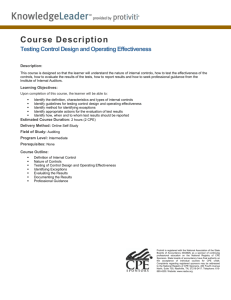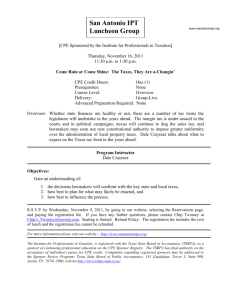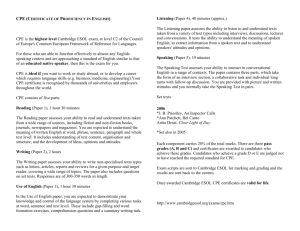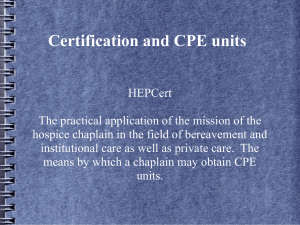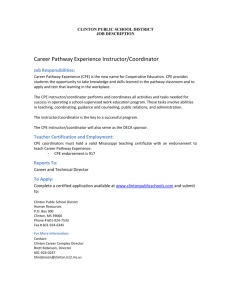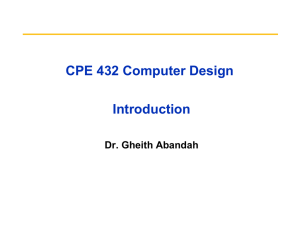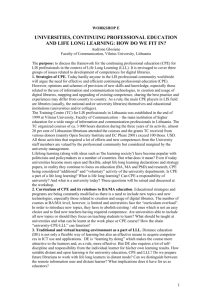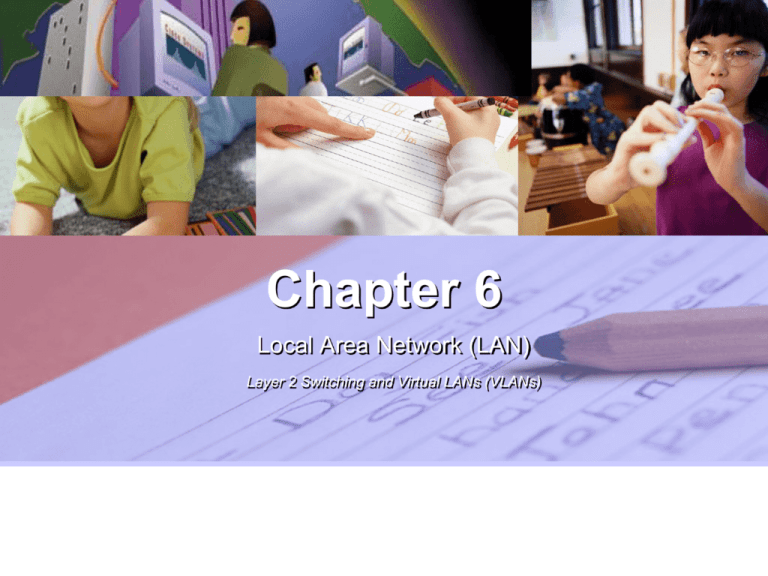
Chapter 6
Local Area Network (LAN)
Layer 2 Switching and Virtual LANs (VLANs)
LOGO
Objectives
2
cpe@rmutt
Bridges
3
cpe@rmutt
802.3 LAN Development: Today’s LANs
4
cpe@rmutt
Devices Function at Layers
5
cpe@rmutt
Factors that Impact Network Performance
Network traffic (congestion).
Multitasking desktop operating systems
(Windows, UNIX, and Mac) allow
simultaneous network transactions.
Faster desktop operating systems
(Windows, UNIX, and Mac) can initiate
faster network activity.
Increased number of client/server
applications using shared network data.
6
cpe@rmutt
Network Congestion
7
cpe@rmutt
Half-Duplex Ethernet Design
8
cpe@rmutt
LAN Segmentation
Segmentation allows network congestion to
be significantly reduced within each
segment.
cpe@rmutt
9
LAN Segmentation with Bridges
10
cpe@rmutt
LAN Segmentation with Routers
11
cpe@rmutt
LAN Segmentation with Switches
12
cpe@rmutt
Ethernet Technologies
13
cpe@rmutt
Types of Ethernet
14
cpe@rmutt
Parameters for 10 Mbps Ethernet Operation
15
cpe@rmutt
Ethernet Frame
16
cpe@rmutt
Manchester Encoding Examples
17
cpe@rmutt
10BASE5 Architecture Example
18
cpe@rmutt
10BASE2 Network Design Limits
19
cpe@rmutt
10BASE-T Modular Jack Pinouts
20
cpe@rmutt
10BASE-T Repeated Network Design Limits
21
cpe@rmutt
Parameters for 100-Mbps Ethernet Operation
22
cpe@rmutt
Ethernet Frame
23
cpe@rmutt
MLT-3 Encoding Example
24
cpe@rmutt
100BASE-TX Modular Jack Pinout
25
cpe@rmutt
NRZI Encoding Examples
26
cpe@rmutt
100BASE-FX Pinout
27
cpe@rmutt
Example of Architecture Configuration
and Cable Distances
28
cpe@rmutt
Types of Ethernet
29
cpe@rmutt
Parameters for Gigabit Ethernet Operation
30
cpe@rmutt
Ethernet Frame
31
cpe@rmutt
Outbound (Tx) 1000Base-T Signal
32
cpe@rmutt
Actual 1000Base-T Signal Transmission
33
cpe@rmutt
Benefits of Gigabit Ethernet on Fiber
34
cpe@rmutt
Gigabit Ethernet Layers
35
cpe@rmutt
1000BASE-SX and LX
36
cpe@rmutt
Gigabit Ethernet Media Comparison
37
cpe@rmutt
Gigabit Ethernet Architecture
Maximum 1000BASE-SX Cable Distances
Maximum 1000BASE-LX Cable Distances
38
cpe@rmutt
Parameters for 10-Gbps Ethernet
Operation
39
cpe@rmutt
10GBASE LX-4 Signal Multiplexing
40
cpe@rmutt
10-Gigabit Ethernet Implementations
41
cpe@rmutt
Introducing Basic
Layer 2 Switching and
Bridging Functions
© 2004 Cisco Systems, Inc. All rights reserved.
42
cpe@rmutt
ICND v2.2—1-42
Ethernet Switches and Bridges
Address learning
Forwarding the filtering decisions
Loop avoidance
43
cpe@rmutt
Transmitting Modes
44
cpe@rmutt
MAC Address Table
• The initial MAC address table is empty.
45
cpe@rmutt
Learning Addresses
• Station A sends a frame to station C.
• The switch caches the MAC address of station A to port E0
by learning the source address of data frames.
• The frame from station A to station C is flooded out to all
ports except port E0 (unknown unicasts are flooded).
46
cpe@rmutt
Learning Addresses (Cont.)
• Station D sends a frame to station C.
• The switch caches the MAC address of station D to port E3 by
learning the source address of data frames.
• The frame from station D to station C is flooded out to all ports
except port E3 (unknown unicasts are flooded).
47
cpe@rmutt
Filtering Frames
• Station A sends a frame to station C.
• The destination is known; the frame is not flooded.
48
cpe@rmutt
Filtering Frames (Cont.)
• Station A sends a frame to station B.
• The switch has the address for station B in the MAC
address table.
49
cpe@rmutt
Broadcast and Multicast Frames
• Station D sends a broadcast or multicast frame.
• Broadcast and multicast frames are flooded to all ports
other than the originating port.
50
cpe@rmutt
Transmitting Frames
Cut-Through
• Switch checks destination
address and immediately
begins forwarding frame
Store and Forward
• Complete frame is received and
checked before forwarding
Fragment-Free
• Switch checks the first 64 bytes,
then immediately
begins forwarding frame
51
cpe@rmutt
Transmitting Modes
52
cpe@rmutt
CONTINUE NEXT WEEK
53
cpe@rmutt
Identifying Problems
That Occur in Redundant
Switched Topologies
© 2004 Cisco Systems, Inc. All rights reserved.
54
cpe@rmutt
ICND v2.2—1-54
Redundant Topology
Redundant topology eliminates single points of failure.
Redundant topology causes broadcast storms, multiple frame
copies, and MAC address table instability problems.
55
cpe@rmutt
Broadcast Storms
• Host X sends a broadcast.
• Switches continue to propagate broadcast traffic
over and over.
56
cpe@rmutt
Multiple Frame Copies
• Host X sends a unicast frame to router Y.
• The MAC address of router Y has not been learned by
either switch.
• Router Y will receive two copies of the same frame.
57
cpe@rmutt
MAC Database Instability
•
•
•
•
•
Host X sends a unicast frame to router Y.
The MAC address of router Y has not been learned by either switch.
Switches A and B learn the MAC address of host X on port 0.
The frame to router Y is flooded.
Switches A and B incorrectly learn the MAC address of host X on port 1.
58
cpe@rmutt
Introducing Spanning
Tree Protocol
© 2004 Cisco Systems, Inc. All rights reserved.
59
cpe@rmutt
ICND v2.2—1-59
Spanning Tree Protocol
• Provides a loop-free redundant network topology by
placing certain ports in the blocking state
60
cpe@rmutt
Spanning Tree Operation
•
•
•
•
One root bridge per network
One root port per nonroot bridge
One designated port per segment
Nondesignated ports are unused
61
cpe@rmutt
Spanning Tree Protocol
Root Bridge Selection
• BPDU = Bridge Protocol Data Unit
(default = sent every two seconds)
• Root bridge = bridge with the lowest bridge ID
• Bridge ID =
In this example, which switch has the lowest bridge ID?
62
cpe@rmutt
Spanning Tree Port States (Cont.)
63
cpe@rmutt
Spanning Tree Operation
64
cpe@rmutt
Spanning Tree Path Cost
65
cpe@rmutt
66
cpe@rmutt
67
cpe@rmutt
68
cpe@rmutt
The Active Topology After Spanning Tree Is Complete
69
cpe@rmutt
Spanning Tree Port States
• Spanning tree transits each port through
several different states:
70
cpe@rmutt
Spanning Tree Recalculation
71
cpe@rmutt
Spanning Tree Convergence
• Convergence occurs when all the switch and
bridge ports have transitioned to either the
forwarding or the blocking state.
• When the network topology changes,
switches and bridges must recompute STP,
which disrupts user traffic.
72
cpe@rmutt
Rapid Spanning-Tree Protocol
73
cpe@rmutt
Rapid Transition to Forwarding
74
cpe@rmutt
Per VLAN Spanning Tree +
75
cpe@rmutt
Introducing VLAN
Operations
© 2004 Cisco Systems, Inc. All rights reserved.
76
cpe@rmutt
ICND v2.2—2-76
VLAN Overview
• Segmentation
• Flexibility
• Security
VLAN = Broadcast Domain = Logical Network (Subnet)
77
cpe@rmutt
VLAN Operation
• Each logical VLAN is like a separate physical bridge.
• VLANs can span across multiple switches.
• Trunks carry traffic for multiple VLANs.
• Trunks use special encapsulation to distinguish between
different VLANs.
78
cpe@rmutt
VLAN Membership Modes
79
cpe@rmutt
802.1Q Trunking
80
cpe@rmutt
Importance of Native VLANs
81
cpe@rmutt
802.1Q Frame
82
cpe@rmutt
ISL Tagging
ISL trunks enable VLANs across a backbone.
Performed with ASIC
Not intrusive to client
stations; ISL header not
seen by client
Effective between
switches, and between
routers and switches
83
cpe@rmutt
ISL Encapsulation
84
cpe@rmutt
Q&A
Q&A
85
cpe@rmutt


